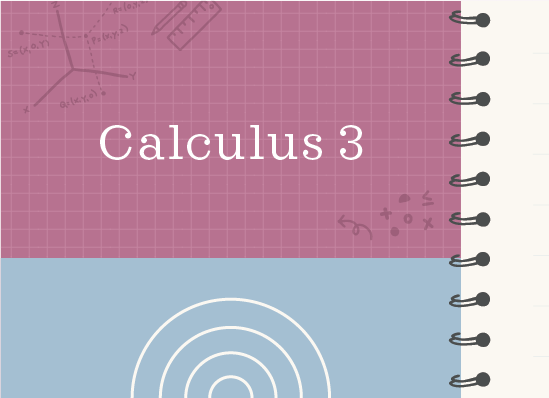Changing triple integrals to cylindrical coordinates
Formulas for converting triple integrals into cylindrical coordinates
To change a triple integral like
???\int\int\int_Bf(x,y,z)\ dV???
into cylindrical coordinates, we’ll need to convert both the limits of integration, the function itself, and ???dV??? from rectangular coordinates ???(x,y,z)??? to cylindrical coordinates ???(r,\theta,z)???.
Hi! I'm krista.
I create online courses to help you rock your math class. Read more.
To do so, we’ll use the conversion formulas
???x=r\cos{\theta}???
???y=r\sin{\theta}???
???z=z???
and
???r^2=x^2+y^2???
to convert the limits of integration and the function ???f(x,y,z)???. ???dV??? will be converted using the formula
???dV=r\ dz\ dr\ d\theta???
How to convert triple integrals into cylindrical coordinates, and then evaluate the converted triple integral
Take the course
Want to learn more about Calculus 3? I have a step-by-step course for that. :)
Evaluate the triple integral in cylindrical coordinates
Example
Evaluate the triple integral in cylindrical coordinates.
???\int^3_{-3}\int^{\sqrt{9-y^2}}_{-\sqrt{9-y^2}}\int^3_{\sqrt{x^2+y^2}}xz\ dz\ dx\ dy???
Let’s start by converting the limits of integration from rectangular coordinates to cylindrical coordinates, starting with the innermost integral. These will be the limits of integration for ???z???, which means they need to be solved for ???z??? once we get them to cylindrical coordinates. The upper limit ???3??? can stay the same since ???z=z??? when we go from rectangular to cylindrical coordinates, but the lower limit needs to be converted using the conversion formulas.
???z=\sqrt{x^2+y^2}???
???z=\sqrt{\left[r\cos{\theta}\right]^2+\left[r\sin{\theta}\right]^2}???
???z=\sqrt{r^2\cos^2{\theta}+r^2\sin^2{\theta}}???
???z=\sqrt{r^2\left(\cos^2{\theta}+\sin^2{\theta}\right)}???
Using the trigonometric identity ???\sin^2{x}+\cos^2{x}=1???, we can simplify to
???z=\sqrt{r^2(1)}???
???z=r???
This means that the limits of integration with respect to ???z??? in cylindrical coordinates are ???[r,3]???.
Next we’ll do the limits of integration for the middle integral. These will be the limits of integration for ???x???, which means they need to be solved for ???r??? once we get them to cylindrical coordinates.
The lower limit is given by
???x=-\sqrt{9-y^2}???
???r\cos{\theta}=-\sqrt{9-\left(r\sin{\theta}\right)^2}???
???r^2\cos^2{\theta}=9-r^2\sin^2{\theta}???
???r^2\sin^2{\theta}+r^2\cos^2{\theta}=9???
???r^2\left(\sin^2{\theta}+\cos^2{\theta}\right)=9???
Since ???\sin^2{x}+\cos^2{x}=1???,
???r^2(1)=9???
???r=\pm3???
The upper limit is given by
???x=\sqrt{9-y^2}???
???r\cos{\theta}=\sqrt{9-\left(r\sin{\theta}\right)^2}???
???r^2\cos^2{\theta}=9-r^2\sin^2{\theta}???
???r^2\sin^2{\theta}+r^2\cos^2{\theta}=9???
???r^2\left(\sin^2{\theta}+\cos^2{\theta}\right)=9???
Since ???\sin^2{x}+\cos^2{x}=1???,
???r^2(1)=9???
???r=\pm3???
It looks like the limits of integration for ???r??? in cylindrical coordinates will be given by ???[-3,3]???. However, remember that ???r??? represents the radius, or distance from the origin. It doesn’t make sense to say that we’re ???-3??? units away from the origin. Instead, we always say that the lower bound for ???r??? is ???0???, such that ???0??? is the closest we can be to the origin (right on the origin), and ???3??? is the furthest we can be from the origin. So the limits of integration for ???r??? will be ???[0,3]???.
Finally, we’ll do the limits of integration for the outer integral. These will be the limits of integration for ???y???, which means they need to be solved for ???\theta??? once we get them to cylindrical coordinates. But since we’re going to ???\theta???, we can just assume that the interval is ???[0,2\pi]???, because that interval represents the full set of values for ???\theta???, which is just the angle between any point and the positive direction of the ???x???-axis.
Next we’ll use the conversion formulas to convert the function itself into cylindrical coordinates.
???xz=r\cos{\theta}z???
???xz=rz\cos{\theta}???
Putting all of this, plus ???dV=r\ dz\ dr\ d\theta??? into the integral gives
???\int^3_{-3}\int^{\sqrt{9-y^2}}_{-\sqrt{9-y^2}}\int^3_{\sqrt{x^2+y^2}}xz\ dz\ dx\ dy???
???\int^{2\pi}_0\int^3_{0}\int^3_rrz\cos{\theta}\left(r\ dz\ dr\ d\theta\right)???
???\int^{2\pi}_0\int^3_{0}\int^3_rr^2z\cos{\theta}\ dz\ dr\ d\theta???
we’ll need to convert the limits of integration, the function itself, and dV from rectangular coordinates to cylindrical coordinates.
We always integrate from the inside out, which means we’ll integrate first with respect to ???z???, treating all other variables as constants.
???\int^{2\pi}_0\int^3_{0}\frac12r^2z^2\cos{\theta}\Big|^{z=3}_{z=r}\ dr\ d\theta???
???\int^{2\pi}_0\int^3_{0}\frac12r^2(3)^2\cos{\theta}-\frac12r^2(r)^2\cos{\theta}\ dr\ d\theta???
???\int^{2\pi}_0\int^3_{0}\frac92r^2\cos{\theta}-\frac12r^4\cos{\theta}\ dr\ d\theta???
Now we’ll integrate with respect to ???r???, treating all other variables as constants.
???\int^{2\pi}_0\frac{9}{2(3)}r^3\cos{\theta}-\frac{1}{2(5)}r^5\cos{\theta}\Big|^{r=3}_{r=0}\ d\theta???
???\int^{2\pi}_0\frac{3}{2}r^3\cos{\theta}-\frac{1}{10}r^5\cos{\theta}\Big|^{r=3}_{r=0}\ d\theta???
???\int^{2\pi}_0\frac{3}{2}(3)^3\cos{\theta}-\frac{1}{10}(3)^5\cos{\theta}-\left[\frac{3}{2}(0)^3\cos{\theta}-\frac{1}{10}(0)^5\cos{\theta}\right]\ d\theta???
???\int^{2\pi}_0\frac{81}{2}\cos{\theta}-\frac{243}{10}\cos{\theta}\ d\theta???
???\int^{2\pi}_0\frac{405}{10}\cos{\theta}-\frac{243}{10}\cos{\theta}\ d\theta???
???\int^{2\pi}_0\frac{162}{10}\cos{\theta}\ d\theta???
???\int^{2\pi}_0\frac{81}{5}\cos{\theta}\ d\theta???
Now we’ll integrate with respect to ???\theta???.
???\frac{81}{5}\sin{\theta}\Big|^{2\pi}_0???
???\frac{81}{5}\sin{(2\pi)}-\frac{81}{5}\sin{(0)}???
???\frac{81}{5}(0)-\frac{81}{5}(0)???
???0???
This means that the volume given by this triple integral is ???0???.






